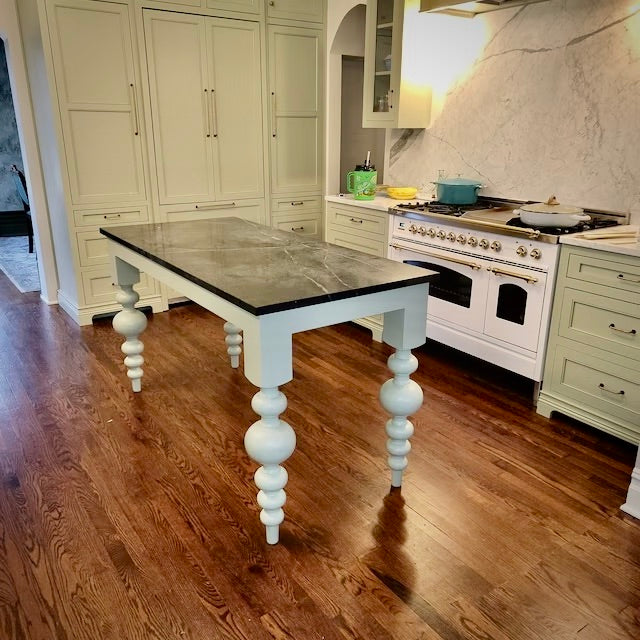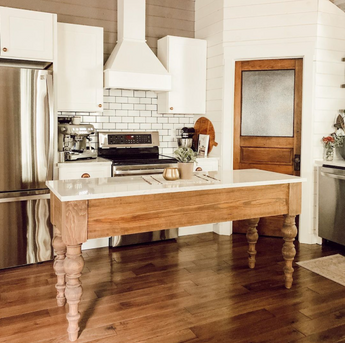Checking Out the Important Features of a Cooking Area Island Leg for Your Culinary Area
The kitchen island offers as a main hub in any kind of culinary room, and the choice of leg style is pivotal in improving both its capability and visual charm. Understanding the necessary features of kitchen area island legs-- including product options, style styles, and security factors-- can substantially influence the overall experience within the kitchen area.
Value of Cooking Area Island Legs
Kitchen island legs play an important function in both the capability and looks of a cooking area space. They not only support the weight of the island but likewise improve the total layout, contributing to the kitchen area's aesthetic allure. The selection of legs can determine the design of the kitchen, be it modern, conventional, or rustic.
Functionally, robust and effectively made legs ensure security, permitting for the secure usage of the island for various tasks such as food preparation, dining, or entertaining. Solid legs prevent wobbling and shifting, supplying a trusted surface for day-to-day tasks.
In addition, the elevation and positioning of the legs can influence the comfort level for those seated at the island. A well-considered elevation can accommodate bar stools or chairs, advertising an inviting setting for events.
In addition to these useful considerations, kitchen island legs can serve as a focal factor in the area (kitchen island leg). Attractive or distinctly made legs can raise the style aesthetic, making the island a focal point. Hence, choosing the best kitchen island legs is essential for stabilizing type and feature in any kind of cooking space
Product Options for Legs
Picking the proper material for kitchen island legs dramatically affects both toughness and design. Usual product choices consist of steel, stone, and timber, each offering distinctive advantages.
Timber is a prominent selection due to its warmth and convenience. It can be easily customized to match various decor styles, from rustic to modern. Woods like oak and maple supply outstanding toughness and durability, while softer timbers can be much more at risk to tear and wear.
Metal legs are preferred for their sleek, contemporary visual. kitchen island leg. Stainless steel and aluminum are not only durable but likewise immune to rust and deterioration, making them optimal for cooking area environments. They can produce an industrial look and are usually offered in numerous finishes to match various other cooking area elements
Rock legs, such as granite or marble, include an element of high-end and security. While larger than other materials, they provide remarkable toughness and can withstand significant weight. Nevertheless, they might call for additional support to make sure appropriate equilibrium.
Eventually, the choice of product need to straighten with both functional needs and the overall layout vision of the kitchen area area, ensuring that the island legs boost both utility and aesthetics.
Layout Styles to Take Into Consideration
What style styles should be considered when selecting legs for a kitchen island? The selection of leg style dramatically influences the general aesthetic of your culinary room. For a contemporary kitchen, smooth and minimalistic leg styles, such as stainless-steel or geometric shapes, can improve the modern charm, giving a clean and clean appearance.
On the other hand, typical kitchens gain from timeless styles such as turned resource or sculpted wood legs, which add heat and personality. These options typically feature elaborate information that complement vintage furnishings. For a rustic setting, consider legs made from reclaimed wood or functioned iron, which bring a natural, natural quality to the area.
If you lean in the direction of an industrial style, durable steel legs with a distressed finish may be optimal, supplying an edgy yet innovative touch. Additionally, farmhouse style kitchens can integrate beefy legs that stimulate a feeling of sturdiness and homeliness.

Elevation and Stability Aspects
The elevation and stability of a kitchen area island are essential aspects that straight impact its performance and customer experience. An ideal kitchen area island leg need to offer adequate elevation to suit a variety of tasks, from cooking to informal eating. Generally, kitchen area islands stand in between 36 to 42 inches high, straightening with basic counter and bar heights. This variety makes certain convenience for users while performing different activities, therefore improving the total use of the room.
Stability is similarly important, specifically as kitchen area islands frequently offer as focal points in cooking atmospheres. The leg's add-on to the island's base must be secure, making certain durability and strength against the wear and tear of day-to-day use.
Modification and Accessories
Modification choices and devices for kitchen island legs can dramatically improve both the visual appeal and capability of the area. Home owners can select from a selection of materials, including rock, timber, and metal, enabling for smooth integration with existing kitchen area style. The choice of surface-- be it an all-natural stain, paint, or powder layer-- further customizes the appearance, ensuring that the island complements the general style motif.
Along with material and surface, home owners might also check out the unification of devices such as ornamental braces, adjustable feet, or integrated shelving. Brackets can use added assistance while adding click for more to a modern or rustic aesthetic. Flexible feet are especially beneficial for uneven flooring, guaranteeing the island stays steady and degree, which is vital for both safety and security and use.

Verdict
In verdict, cooking area island legs offer an important function in supplying stability and enhancing the overall visual of the cooking area. Personalization choices and accessories can raise the kitchen island, making it a distinctive focal factor within the home.
The cooking area island serves as a central center in any kind of culinary space, and the choice of leg layout is crucial in improving both its performance and visual allure. Comprehending the essential attributes of kitchen area island legs-- including product choices, design styles, and security aspects-- can substantially impact the total experience within the kitchen area.Kitchen island legs play a crucial duty in both the performance and aesthetic appeals of a kitchen area.What design styles should be taken into consideration when choosing legs for a cooking area island?In final thought, kitchen island legs click here for more offer a critical duty in offering security and enhancing the total aesthetic of the cooking space.